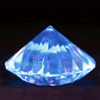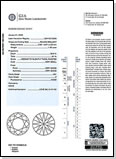We received a call from Amy, local client, who asked if we sold triangular diamond side stones. She said she had a radiant diamond with triangular side stones but wanted to replace them with something better. She came to our office and showed us her ring. She said the side stones never looked right to her because they did not sparkle and asked if that was the case for all triangular side stones.
It is always difficult to know what to say to a client who comes in to our office with a diamond ring that is not up to the standards of what we would normally sell. However in this case Amy was asking for our help and our opinion. We told her the reason her side stones did not look right was because they were poorly cut. Neither stone had much sparkle. One of the stones was cut so poorly that it was windowy and looked different than the other side stone.
We ordered in a pair of triangular side stones that had great cut and beautiful sparkle so she could see what was possible for upgrading her ring. Throughout our discussions we assumed that this was an older ring and she was just ready for change but we were shocked to discover she had just purchased this custom ring. She had traded in her old engagement diamond plus paid the jewelry store a substantial amount for the new ring. She did not find out about us until after her purchase and was sickened to find out that not only had they provided poorly cut diamonds, she could have bought a ring from us for less than she paid for her new ring and kept her old engagement diamond to make another piece of jewelry out of it.
 When we examined the radiant center stone, we discovered it had strong blue fluorescence. Amy had told us the diamond was GIA certified, so we asked Amy if she was aware that the radiant had strong fluorescence and if they jewelry store had explained that to her. Then she shocked us by saying she had never seen the certification and was never given the original certification even after the purchase.
When we examined the radiant center stone, we discovered it had strong blue fluorescence. Amy had told us the diamond was GIA certified, so we asked Amy if she was aware that the radiant had strong fluorescence and if they jewelry store had explained that to her. Then she shocked us by saying she had never seen the certification and was never given the original certification even after the purchase.
 We told Amy this was all too common in jewelry stores and that it could mean: 1) The diamond was not GIA certified but maybe had an EGL or some less reliable documentation, 2) The diamond was not certified at all or 3) There is something on the certification, like strong fluorescence, they did not want her to see. Since every diamond a jewelry store has that is GIA certified would come with at least a copy of the certification, we could think of no positive reason they had not shown her the certification before the purchase or given it to her when she purchased the diamond. Amy said she did not feel good about how the diamonds looked when she got the ring but said she took it anyway because the sales people were so “slick” and the pressure was so great to buy.
We told Amy this was all too common in jewelry stores and that it could mean: 1) The diamond was not GIA certified but maybe had an EGL or some less reliable documentation, 2) The diamond was not certified at all or 3) There is something on the certification, like strong fluorescence, they did not want her to see. Since every diamond a jewelry store has that is GIA certified would come with at least a copy of the certification, we could think of no positive reason they had not shown her the certification before the purchase or given it to her when she purchased the diamond. Amy said she did not feel good about how the diamonds looked when she got the ring but said she took it anyway because the sales people were so “slick” and the pressure was so great to buy.
When she went back to the jewelry store and asked for her certification, they could not produce it. Amy said she was not and would never be happy with the ring, especially now that she knew about the fluorescence. She asked for them to return her original engagement diamond and to refund the thousands of dollars she had paid them. They said she had seen the diamonds before they made the ring; at best they might give her a store credit. In other words, even though she now knew how much they overcharged her and how they had mislead her, she would still have to purchase something else from them at their inflated prices.
We have offered to coach her on what she should insist on this time. In particular, she should be able to examine the certification for the diamond and the cut parameters and specifications should be in the range that would likely produce a beautiful ring. She said she was so sad that we would not make a sale even after ordering the side stones in for her. We told her that we help clients every day who have purchased elsewhere and that we believe every diamond shopper deserves honest advice and the best assistance we can provide even if it means not purchasing from us as was the case in this situation.
Lessons to be learned:
- We recommend GIA or AGS certifications for diamonds over 0.5 carats.
- If the diamond retailer says the diamond is GIA certified, insist on seeing at least a copy of the certification before you purchase.
- Since wholesalers often keep the original certifications for diamonds they send to retailer on memo, it can take several weeks for the original certification to get to the retailer after you have purchased a diamond. Still, the consumer who purchases a certified diamond deserves the original certification and should be given that as soon as possible.
- It is the diamond shopper’s responsibility to be knowledgeable about diamonds; at least enough to ask the appropriate questions.
- Be sure to examine diamonds in various lighting conditions. The special spot lights in a jewelry store are all designed to make even poorly cut diamonds look good.
- However, you don’t get to take those lights with you so you want the diamond to look good in all lighting conditions.
